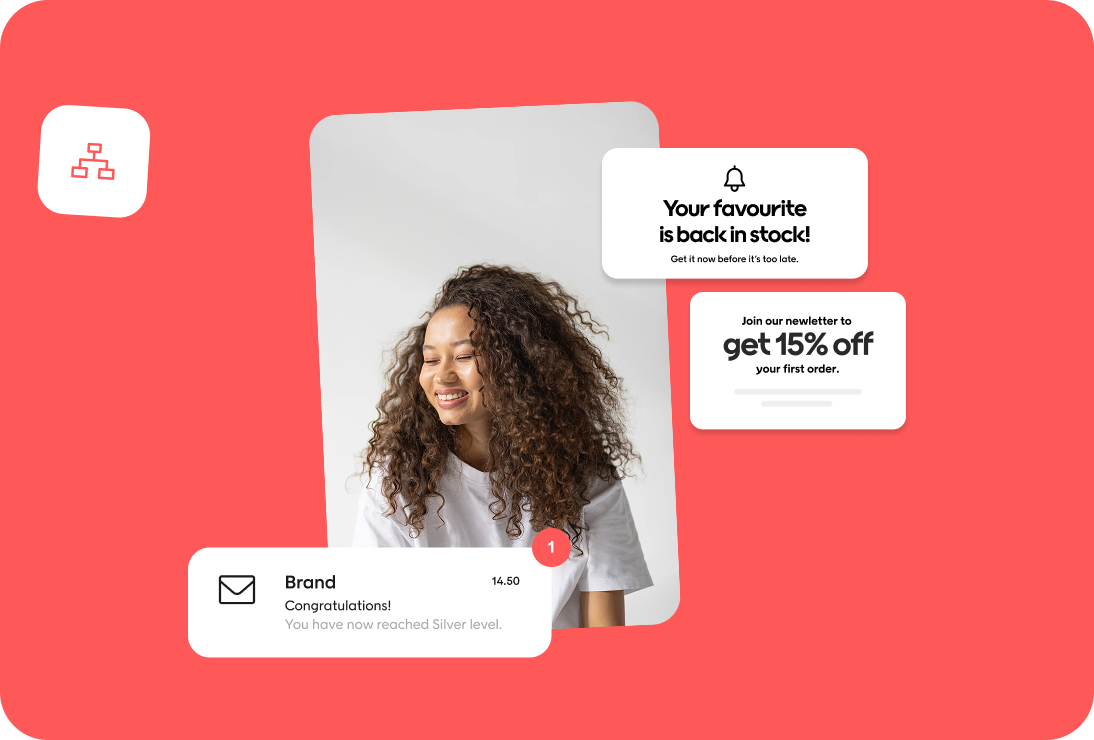TL;DR
- Multichannel retailing connects customers through several independent sales and marketing channels.
- Omnichannel retailing unites all those channels around a single customer view, delivering one continuous experience.
- The key difference is data: omnichannel integrates customer data across touchpoints, while multichannel keeps it siloed.
- True omnichannel strategies increase loyalty, retention, and ROI by removing friction between online and offline experiences.
- Voyado helps retailers connect every channel, unify customer data, and create seamless journeys that boost engagement and revenue.
Your customers don’t think in channels. They expect your brand to remember who they are, wherever they shop.
Inside your business, those same journeys often get lost between systems and teams. The result is missed opportunities and loyalty programs that never reach their potential.
That’s the real difference between omnichannel and multichannel retailing. When your customer data and marketing work as one, every interaction becomes smoother for customers and more valuable for your business.
Retailers using omnichannel marketing see it every day: Higher retention, deeper engagement, and operations that finally run in sync.
So why stay in multichannel strategy mode when you can build a connected omnichannel experience that supports every customer journey?
Why this debate still matters for a seamless customer experience
Your shoppers no longer see a difference between your website, app, or physical store. They expect one consistent experience, no matter how they move between channels.
But for many retailers, those channels still operate independently. Customer data sits in silos. Marketing teams repeat the same work in different systems. The result is wasted effort and disjointed communication that customers notice right away.
Here’s why this matters:
- Customer expectations are higher than ever. People expect personalization and recognition at every touchpoint.
- Disconnected systems create friction. When channels don’t share data, every interaction feels like starting over.
- Unified insight drives growth. Retailers with an omnichannel setup use shared data to build loyalty, improve targeting, and increase ROI.
Understanding omnichannel vs multichannel retailing helps you decide whether your business runs on connected customer insight or on scattered data that can’t scale.
Retailers using omnichannel retailing already see stronger loyalty, smoother operations, and faster responses to customer needs. When every interaction builds on the last, you don’t just meet expectations, you exceed them.
To see how, let’s clarify what each model actually means and where the real differences lie.
Omnichannel vs multichannel marketing – The key differences
Before you can decide which approach fits your business, it helps to understand how these two models really work.
Both aim to reach your customers across multiple touchpoints, but they’re built on very different foundations.
What is multichannel retailing?
Multichannel retailing means selling and communicating through several independent channels, such as your online store, physical stores, and email marketing. Each channel operates on its own, with its own data, campaigns, and goals.
This structure makes it easy to expand quickly, but it also creates friction that customers can feel:
- Disconnected offers. A promotion shown online may not apply in-store.
- Inconsistent messages. Emails or ads might not reflect recent purchases.
- Data silos. Each channel collects information separately, so your teams never see the full picture.
These gaps weaken the customer journey and make your marketing efforts harder to coordinate across channels.
What is omnichannel retailing?
Omnichannel retailing connects every channel through shared customer data, loyalty logic, and consistent communication. Each touchpoint works as part of one system instead of running alone.
Here’s how it works in practice:
- Shared data. A product added to a cart on mobile appears instantly in-store.
- Connected loyalty. Points earned online are redeemable during the next in-store visit.
- Unified experience. The brand looks, feels, and behaves the same everywhere.
It’s one continuous experience. For your teams, it means less manual work. For your customers, it feels personal, predictable, and seamless.
Multichannel retailing vs omnichannel retailing: A side-by-side comparison
Here’s how the two approaches differ at a glance:
| Area | Multichannel | Omnichannel |
| Strategy focus | Channels run in parallel with limited coordination | Unified strategy across all customer touchpoints |
| Customer data | Stored separately per channel | Shared, consistent profile across systems |
| Personalization | Channel-level targeting | Cross-channel journeys and predictive audiences |
| Loyalty | Basic earn and redeem rules per channel | Points, tiers, and perks are shared across all |
| Measurement | Channel KPIs (email, store, SMS) | Customer and cohort-level performance |
| Complexity | Easier to start, harder to scale | Higher setup effort, stronger long-term payoff |
The takeaway
Multichannel retailing is about being present in many places, while omnichannel retailing is about making every place feel like one.
Why understanding this matters for your business
Understanding omnichannel retail vs multichannel helps you see where your customer experience stands today. The stronger your data connection, the easier it becomes to build trust, increase loyalty, and grow your revenue.
Next, let’s look at how to choose the right approach for where your business is right now.
Which marketing strategy fits your retail business today?
Now that you understand the differences, the next step is knowing which approach makes sense for your business right now.
The truth is, both multichannel marketing and omnichannel marketing have value. It depends on where you are in your data and customer journey maturity.
Here’s a simple way to see where you stand:
| If this sounds like your business… | Then your best fit is… |
| You want to reach customers through multiple channels fast. | Multichannel – ideal for building presence and testing what works. |
| Your teams or budgets are managed separately by channel. | Multichannel – easier to coordinate with less complexity. |
| You don’t yet have shared customer IDs or connected systems. | Multichannel – start here, but plan your move toward omnichannel. |
| You can connect customer data across your POS, ecommerce, and app. | Omnichannel – ready to unify experiences and track full journeys. |
| You already manage loyalty and consent in one system. | Omnichannel – time to scale with personalization and automation. |
| You want to measure success at the customer or cohort level. | Omnichannel – better data, stronger retention insights. |
Both strategies can deliver results when used intentionally:
- Multichannel retailing helps you reach more people quickly.
- Omnichannel retailing helps you build loyalty through connected, data-driven experiences.
If you’re exploring platforms that can support the shift, check out the best omnichannel CX platforms for a clearer picture of what’s possible.
Wherever you start, the goal is the same: move toward a customer experience that feels unified, not duplicated.
Before you make that shift, let’s make sure your foundations are ready to support it.
How to prepare for omnichannel marketing success
Moving from a multichannel retail strategy to a true omnichannel marketing strategy takes preparation. You need the right data, systems, and workflows in place before your team can deliver consistent customer experiences across every touchpoint.
Use this checklist to see if your business is ready:
1. Customer identity
Can your systems recognize the same customer across multiple channels?
If not, start here. Your POS, ecommerce, and app need to share a single customer ID so every interaction contributes to one profile. This is the foundation of any strong omnichannel strategy.
2. Customer consent
Make sure customer permissions and preferences are managed centrally.
When consent data is unified, your omnichannel marketing efforts stay compliant and relevant no matter which channel customers choose.
3. Customer data
Your data should move freely between systems, not sit in silos. Product, transaction, and engagement information must stay connected in real time.
That’s how teams can act on insights and improve customer engagement at every step of the customer journey.
4. Marketing automation software
If your team still switches between tools to manage campaigns, it’s time to upgrade.
Use marketing automation software that combines loyalty, segmentation, and personalized journeys in one place. This keeps your customer interactions consistent and meaningful.
5. Customer journey mapping
Define key touchpoints such as browse, add to cart, purchase, redeem, and return. Standardizing these actions helps your teams see the full journey and fine-tune every step for retention.
6. Attribution and measurement
Look beyond channel-level performance. Track engagement and loyalty at the customer or cohort level.
A mature omnichannel marketing strategy uses these insights to refine messaging and strengthen long-term relationships.
If you want to learn more about building a connected retail foundation, explore our guide to succeeding with omnichannel retailing.
Being ready doesn’t mean being perfect. It means having the structure and tools to grow toward a more unified, customer-focused approach.
Once you’ve built that foundation, you can start transforming how your teams work every day. That’s where omnichannel truly comes to life.
How omnichannel changes your daily operations
Once your foundation is ready, the real transformation begins.
Omnichannel marketing changes how teams plan, create, and measure every customer interaction. You aren’t just adopting a shift in tools or technology. You and your teams are adopting a new way of working that connects your marketing efforts around one shared customer experience.
From planning by channel to planning by journey
What this looks like in practice
In a multichannel setup, each team runs its own calendar and campaigns. Stores, ecommerce, and email all work separately, often repeating similar messages.
With an omnichannel strategy, planning happens around the customer journey instead. Journeys connect multiple touchpoints, using shared customer data to keep every message relevant.
How your business and customers benefit
Your teams collaborate more easily, using the same insights to drive every campaign. The result is a consistent customer experience that builds trust and keeps your audience engaged.
From repetitive tasks to smarter automation
What this looks like in practice
Manual scheduling and segmentation used to take hours. Now, marketing automation software can trigger personalized offers, product recommendations, and loyalty messages automatically.
These tools connect all your channels, helping your marketing strategies run smoothly.
How your business and customers benefit
Your teams save time and can focus on creative work that drives growth. Customers receive timely and meaningful interactions, improving satisfaction and loyalty.
From one-size-fits-all to personalized engagement
What this looks like in practice
A multichannel retail strategy often treats everyone the same. Omnichannel marketing uses shared data to create personalized experiences based on preferences and behavior.
Each customer interaction feels more natural because it’s driven by real insights.
How your business and customers benefit
Every message feels tailored, improving customer engagement and long-term relationships. Personalization also boosts response rates and helps convert one-time buyers into loyal members.
From channel metrics to customer impact
What this looks like in practice
Traditional teams measure success by channel KPIs like open rates or store conversions. An omnichannel marketing strategy looks beyond that. It connects performance data to customer lifetime value, retention, and overall experience.
How your business and customers benefit
Your business gains a full picture of what drives engagement and sales.
Customers notice the improvement too, as their experiences feel more cohesive and rewarding across all touchpoints.
When your operations align around the customer, everything becomes easier to manage and measure.
Teams collaborate better, and marketing work becomes more creative and effective.
Next, let’s explore examples of omnichannel and multichannel campaigns you can adapt for your own brand.
Omnichannel and multichannel examples to inspire your next campaign
Now that you know how omnichannel changes daily operations, let’s see what that looks like in real marketing campaigns.
These examples highlight how multichannel and omnichannel marketing strategies differ in approach, coordination, and impact on customer relationships.
Multichannel campaign examples
1. Seasonal product promotion
What it is
Each channel, such as social media, email, and physical retail stores, runs its own version of a seasonal sale. Teams follow separate plans, and results are tracked independently.
Why it works
This multichannel approach helps reach customers fast across different channels. It’s ideal for brands still refining their digital marketing strategy or testing which messages resonate best with their target audience.
2. Single-channel loyalty reminder
What it is
A simple email campaign that reminds customers to redeem unused points.
Why it works
It builds awareness and encourages repeat purchases, but since channels operate independently, results don’t contribute to a unified view of customer loyalty or retention.
3. Flash sale across separate channels
What it is
A 24-hour sale announced through social media, SMS, and paid ads. Each team manages its own creative and timing.
Why it works
This multichannel marketing work creates quick bursts of activity and drives traffic, even if it lacks seamless integration between various channels.
4. Store event announcement
What it is
Individual stores promote local events or launches through in-store signage and regional newsletters.
Why it works
It strengthens community engagement and brand awareness, but without unified customer data, it can’t enhance customer engagement or measure the long-term effect on retention.
Omnichannel campaign examples
1. Click-and-collect loyalty boost
What it is
Customers reserve items online and pick them up in-store, earning personalized offers or extra loyalty points.
Why it works
This omnichannel approach connects digital and physical experiences through one seamless customer journey. It supports higher conversion and customer satisfaction while building long-term loyalty.
2. Back-in-stock with store options
What it is
Automated emails and SMS updates alert customers when items are available again, showing online and in-store stock.
Why it works
Omnichannel marketing focuses on connected experiences. This campaign uses real-time data from multiple systems to deliver consistent experiences and drive faster sales.
3. Win-back by channel preference
What it is
A reactivation flow that adapts based on customer behavior by switching from email to push, SMS, or social channels, depending on what works best.
Why it works
Omnichannel marketing integrates insights from multiple touchpoints to anticipate customer preferences. It improves customer retention and strengthens loyalty without overspending on repeated marketing campaigns.
4. Tier upgrade push
What it is
Loyalty members receive progress updates and personalized rewards when they are close to their next tier.
Why it works
This omnichannel retail strategy turns customer data into motivation. It builds a consistent experience that improves retention, drives repeat purchases, and enhances customer relationships.
The takeaway
Multichannel marketing strategies focus on visibility across different channels. Omnichannel marketing focuses on connection and consistency across every customer touchpoint.
Both matter, but only omnichannel delivers the seamless integration and personalized experiences that improve customer loyalty and retention over time.
Measure what matters: Prove your marketing efforts deliver
Great campaigns only matter if you can prove they work. That’s where omnichannel shines.
It connects every action, making it easy to see which marketing efforts actually build loyalty and long-term growth.
Why measurement matters
In a multichannel setup, performance is tracked by channel. You might see great email results but have no idea how they influence in-store sales.
With an omnichannel approach, all customer interactions are connected, giving you one clear view of impact across every journey.
What to measure
Focus on a few key metrics that reflect real progress:
- Customer retention: How many people keep coming back, and how quickly.
- Customer loyalty: Growth in points redeemed, tier upgrades, or repeat purchases.
- Customer satisfaction: Feedback trends across online and in-store experiences.
- Engagement across channels: How your campaigns influence activity throughout the customer lifecycle.
When your data tells one story, decisions get easier. You can spot what drives growth, improve customer retention, and make every marketing campaign count.
Next, let’s look at how to scale that success and move from multichannel to omnichannel in just 90 days.
How to move from multichannel to omnichannel in 90 days
You don’t need a complete system overhaul to get started. With the right plan, you can begin moving toward omnichannel marketing in just 90 days. Here’s a simple roadmap with clear checkpoints to help you track progress along the way.
Days 1–30: Unify your foundation
Start by connecting what you already have.
- Sync your customer data: Make sure your ecommerce, CRM, and POS systems share the same customer IDs and consent information.
- Map your key journeys: Identify where customers interact with your brand across different channels.
- Audit your current setup: Look for duplicate data, missing touchpoints, or gaps in personalization.
Checkpoint: By the end of the first month, your systems should share one customer view, and your team should know exactly where every interaction happens.
Days 31–60: Build and automate key journeys
Now that your foundation is connected, start creating experiences that span multiple channels.
- Automate simple journeys: Welcome emails, browse recovery, and loyalty reminders.
- Personalize communication: Use real-time data to trigger the right message at the right time.
- Test and learn: Compare customer engagement across different channels to see where your marketing efforts perform best.
Checkpoint: By the midpoint, your team should be running at least two automated, cross-channel journeys and tracking their results.
Days 61–90: Measure, refine, and scale
Use data from your early campaigns to optimize and expand.
- Analyze results: Look at customer retention, purchase frequency, and loyalty engagement.
- Refine journeys: Adjust timing, offers, and triggers based on performance.
- Scale success: Roll out proven journeys to new segments or regions.
Checkpoint: By the end of 90 days, your business should be running consistent, data-driven journeys that connect marketing, loyalty, and customer experience in one system.
Becoming truly omnichannel doesn’t happen overnight, but steady progress does. Focus on what creates visible value for your teams and customers, and the rest will follow.
Next, let’s look at some common challenges and how to stay on track.
What can slow you down (and how to stay on track)
Even with a clear plan, a few things can make your omnichannel progress stall. The good news? They’re easy to spot and fix once you know what to look for.
1. Disconnected data
If your systems don’t share information, you’ll always be a step behind your customers.
How to stay on track: Start with your customer data. Unify IDs, consent, and purchase history so every channel tells the same story.
2. Loyalty programs that focus only on discounts
Discounts bring quick wins but don’t build emotional loyalty.
How to stay on track: Add experiential rewards like early access, exclusive content, or service perks that strengthen the relationship and protect your margins.
3. Teams working in silos
When marketing, ecommerce, and store teams plan separately, customers feel the gaps.
How to stay on track: Create shared goals and use the same reporting dashboards. Small alignment meetings can go a long way toward improving collaboration.
4. Measuring the wrong success metrics
Tracking open rates or traffic alone won’t show the real impact of omnichannel marketing.
How to stay on track: Focus on long-term metrics like customer retention, lifetime value, and engagement across all channels.
Omnichannel success is about progress, not perfection. By staying connected, aligned, and focused on what your customers actually value, you’ll keep momentum and results, moving in the right direction.
Now, let’s wrap up with how Voyado supports this journey and helps retailers turn their strategy into measurable growth.
How Voyado makes omnichannel marketing work
Every strong omnichannel strategy starts with the right technology. Voyado brings your data, journeys, and loyalty together in one platform so your teams can deliver consistent experiences across every channel.
Unified customer view
See every interaction in one place, from online purchases to in-store visits. With one profile for each customer, you can recognize them instantly and personalize every message.
Cross-channel activation
Reach your audience through the right channels at the right time. Voyado connects email, SMS, app notifications, and in-store triggers to keep your marketing campaigns seamless and relevant.
Loyalty built in
Reward your customers in ways that go beyond discounts. Voyado helps you create points programs, tiers, and exclusive perks that strengthen emotional loyalty and improve customer retention.
“When we create emotional loyalty through personalized experiences, we turn every interaction into something meaningful.” – Laufey Lúðvíksdóttir, CRM and Loyalty Specialist at By Malene Birger
Predictive insights and personalization
Voyado uses your customer data to anticipate behavior and suggest the next best action. This makes it easy to enhance customer engagement and build stronger relationships over time.
Meaningful measurement
Understand what drives growth with cohort tracking, holdout testing, and incremental lift reporting. You can clearly see how your marketing efforts impact sales, loyalty, and customer satisfaction.
Omnichannel isn’t just a marketing upgrade; it’s how modern retail works.
With Voyado, you can connect loyalty, engagement, and data in one place and turn your omnichannel retail strategy into measurable success.
Book a demo to see how Voyado helps retailers like you deliver experiences customers remember and return to.
FAQs
What is the main difference between omnichannel and multichannel retailing?
Multichannel retailing uses several independent channels that work in parallel. Omnichannel retailing connects those same channels through shared customer data, creating one continuous experience across every touchpoint.
Is Amazon omnichannel or multichannel?
Amazon is a strong example of omnichannel retailing. It connects online, mobile, and physical stores through shared customer accounts, personalized recommendations, and unified order tracking.
How do I measure success beyond channel KPIs?
Look at metrics that show long-term value, such as customer retention, loyalty program engagement, and repeat purchase rates. These reveal the real impact of your omnichannel marketing efforts.
Do I need a CDP to run omnichannel marketing?
A customer data platform (CDP) helps unify customer data from multiple systems, which is essential for accurate targeting and measurement. With Voyado, the CDP is built in, giving you a complete view of every customer without adding extra tools.
How does loyalty change when I move from multichannel to omnichannel?
Loyalty programs shift from isolated earn-and-redeem offers to experiences that recognize customers across all channels. With shared data and connected rewards, every interaction strengthens emotional loyalty and brand connection.









